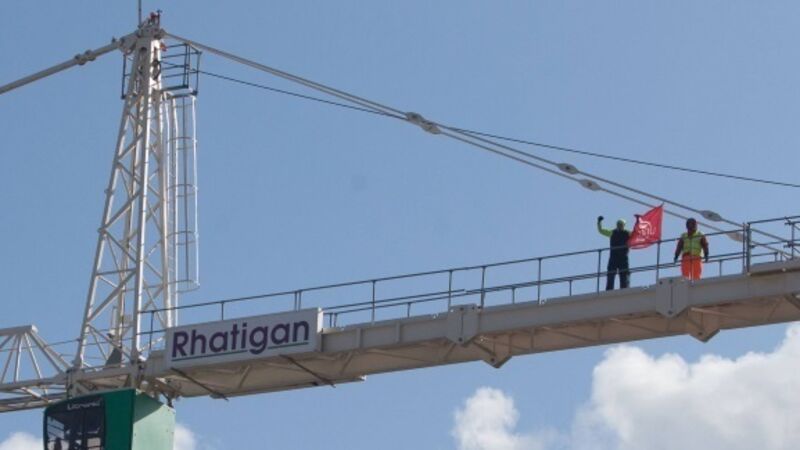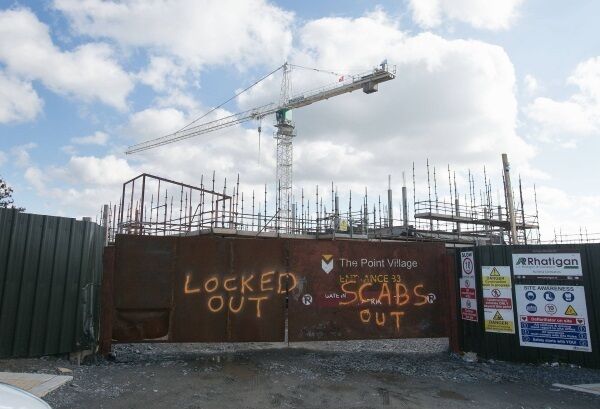Blacklisted workers run up against a brick wall

Alex was on the site for all of four hours when he was told to leave. He wasn’t told why, but he didn’t have to ask.
That was eight weeks ago. The site was in Dublin. He had got the job through an agency, and it took just four hours after his appearance that morning for word to filter through as to his identity.
Three months before that he lasted a day and a half on another building site, also in Dublin, before the inevitable approach was made.
“I was working for a subbie there,” he says. “He just came over to me and said they don’t want you here. What can you do?”
Alex (not his real name) is blacklisted. The construction industry in Ireland is relatively small. Word has gone around, a few whispers here, names spat out through gritted teeth there. This guy is no good. It’s not his work that’s the problem, just that he doesn’t know his place in the order of things.
“I’m linked into every [employment] agency,” he says.
“But I’m just working here and there, bits and pieces. I get onto a site and then I keep getting thrown off them once they find out who I am.”
Alex’s troubles began over two years ago as a result of a strike on a site in Lucan. Last week, Alex gave evidence at a hearing that could set a major precedent in employment policy, yet was held in secret.
The appeals office of the social welfare department heard an appeal by construction company JJ Rhatigan against a ruling that eight tradespeople and a labourer were directly employed by the company.
Rhatigan claimed they were employed through a sub-contractor, and therefore not entitled to the status of employees.
The issue led to the strike in question and is a crucial one that has grown in importance since the economic recovery. Some employers are opting not to employ some workers directly. This avoids the cost of employment, such as PRSI, pension payments, sick and holiday pay.
For some workers this arrangement suits. Other though would much prefer to be employed as befitting their work. Apart from the obvious security, issues can also arise in entitlement to job seeker’s allowance when work dries up. There is also the security of ensuring that registered trade agreements are adhered to, which often isn’t the case in the unregulated world of sub-contractors.
From the employer’s perspective, there are cost savings and crucially, the ability to hire and fire depending on circumstances. For many workers it amounts to an old fashioned transfer of wealth from labour to capital.
***
The bricklayers began work on the site on 26 May 2014. (Those contacted by the Irish Examiner didn’t want their identities publicly revealed for obvious reasons). In total there were 13 tradesmen and a general labourer.

The job was to build a new community college at Kishoge in Lucan, west Dublin. Rhatigan, one of the biggest firms in the State, was the main contractor. The men were employed by something of a self-styled sub-contractor who disappeared three weeks after the men began work.
Traditionally, a subbie would be a tradesperson himself. He would receive instructions from the main contractor and then allocate to his men the work required to be done.
On the Kishoge site, the brickies received their instructions directly from a Rhatigan project manager, as the man who had hired them was rarely on site himself.
No wages were paid for the first two weeks. Eventually, one of the men was paid in the third week, but only partially. Soon after that the sub-contractor left the site and never returned.
Rhatigan now had a problem. These bricklayers were working on the site, but for whom? Two of the men were approached by a company representative with the suggestion that they set up their own company to employ them and their colleagues.
The pair “made it clear that they were not in a position to become sub-contractors and did not have the appropriate training or resources to do so,” according to a submission to the Labour Court. They claim that they were told “they either become sub-contractors or they could leave the site”.
The company was set up, but the men got independent advice to say that it was not in compliance with Revenue rules.
“The bricklayers were constantly attempting to formalise their employment relationship with JJ Rhatigan and they were being stonewalled,” the submission claimed.
Tensions continued and after a further dispute over the employment status and two of the bricklayers were told to leave the site on August 28. A strike ensued that spread to three other Rhatigan sites, and involved a high-profile stand-off when two of the bricklayers mounted a crane and remained up there for three days.
After a number of visits to the High Court, the matter was referred to the Labour Court. It issued a ruling in January 2015 that the men be paid €100,000 in full and final settlement.
In addition, the Labour court stated that it “recommends that the parties exchange assurances that there will be no victimisation of any person arising from their involvement or non-involvement in the dispute.”
Three of the men to whom the Irish Examiner has spoken claim there has been victimisation in the form of blacklisting them off sites.
There is absolutely no suggestion that Rhatigan sanctioned, engaged in or promoted the blacklisting. A spokeswoman for Rhatigan said the company knows nothing about this blacklisting. “We weren’t aware of that and we wouldn’t support any such action in relation to it,” she said.
Peter, who was involved in the dispute, has worked as a bricklayer since he left school at 16. He is now 56, with little prospect of continuing in the one trade he has known.
“If I go on site, what they do is take your details,” he says. “Most jobs are by subbies now, but when they check me out they see I was in the dispute and won’t take me on. It’s a closed community. In Dublin most bricklayers know each other.”
Peter is in the process of acquiring qualifications as a machine operator, hoping his reputation won’t follow him into a different line of work: “I’ve been on jobseeker’s allowance for a year now,” he says. “I want to get into something. It might still be in construction but it’s a different line. They wouldn’t know my history.”
The Irish Examiner understands that two of the other men involved in the dispute have immigrated to London.
***
In parallel with the Labour Court process, a number of the men applied to the Social Welfare office, which adjudicates on disputes over whether somebody should be claissified as an employee or self-employed on a particular contract.
After a hearing in which both sides were represented, the adjudicating body, known as Scope, ruled the men had been employees.
That in turn was appealed to the Social Welfare Appeals Office, which sat last week in Dublin. The office heard from eight of the men who were originally involved in the case. The outcome was reserved and it could be a number of months before a ruling is delivered.
The outcome could have a major impact on employment in the construction sector. An estimated 30,000 workers in the sector are classified as self-employed.
If the appeals office confirms the Scope ruling it could lead to a whole slew of cases of workers seeking to have their employment reclassified, which would come at a major financial cost to employers, not to mention a reconfiguration of employment practices.
The premise for secret hearings was to ensure confidentiality, as the vast majority of appeals relate to individuals accessing state benefits of one kind or another. It was never intended that such weighty matters as were being discussed last week should be shut out from the public glare, but that is what has happened.
Sources close to the process suggest that should the appeals office reject Rhatigan’s appeal, there will definitely be a further appeal to the High Court.
The company spokeswoman said she would not speculate.
“We are confident of our case and respect the process so we’ll wait to see the outcome,” she said.
Should Rhatigan win the appeal, the financial cost of going to the High Court would most likely deter the bricklayers from pursuing that course of action.












